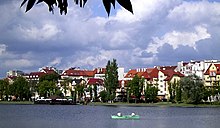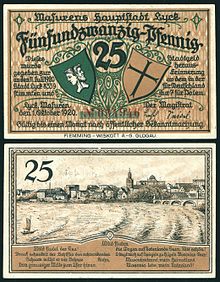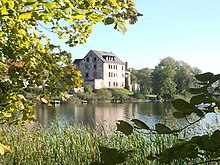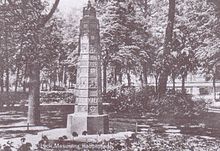Ełk
| Ełk | ||
|---|---|---|
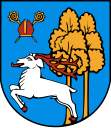
|
|
|
| Basic data | ||
| State : | Poland | |
| Voivodeship : | Warmia-Masuria | |
| Powiat : | Ełk | |
| Area : | 21.07 km² | |
| Geographic location : | 53 ° 49 ' N , 22 ° 21' E | |
| Height : | 147 m npm | |
| Residents : | 62.006 (June 30, 2019) |
|
| Postal code : | 19-300 | |
| Telephone code : | (+48) 87 | |
| License plate : | NEL | |
| Economy and Transport | ||
| Street : |
DK 16 : Grudziądz - Olsztyn - Mrągowo ↔ Augustów - Ogrodniki (- Lithuania ) |
|
|
DK 65 : ( Russia -) Gołdap - Olecko ↔ Grajewo - Białystok - Bobrowniki (- Belarus ) |
||
| Ext. 656 : ( Giżycko -) Staświny - Zelki → Ełk | ||
| Rail route : |
Giżycko – Ełk – Białystok ; Czerwonka – Ełk (freight traffic to Orzysz ) |
|
| Olsztyn – Ełk | ||
| Next international airport : | Warsaw | |
| Danzig | ||
| Gmina | ||
| Gminatype: | Borough | |
| Surface: | 21.07 km² | |
| Residents: | 62.006 (June 30, 2019) |
|
| Population density : | 2943 inhabitants / km² | |
| Community number ( GUS ): | 2805011 | |
| Administration (as of 2015) | ||
| City President : | Tomasz Andrukiewicz | |
| Address: | ul. Piłsudskiego 4 19-300 Ełk |
|
| Website : | www.elk.pl | |
Ełk [ ɛwk ] ( German Lyck ) is a medium- sized town in the Polish Warmian-Masurian Voivodeship . It is the center of the powiat Ełcki .
location
Ełk is located in historic East Prussia , around 150 km east of the city of Olsztyn (Allenstein) in Masuria on Lake Lyck ( Jezioro Ełckie in Polish ), 136 meters above sea level. The distance to the Russian Kaliningrad (Königsberg) in the northwest is about 190 kilometers. The place extends on the east bank of the Lyck-See.
Place name
The German place name Lyck is derived from the Prussian “luka” and is the name for the yellow mummel, a pond rose . The Polish form Ełk was created by separating from “we Łku” and also refers to swamp and water plants.
City structure
The city (Miasto) Ełk is divided into 13 districts and settlements ( Polish: Dzielnice i osiedla Ełku ):
- Baranki
- Bogdanowicza
- Center
- Grunwaldzkie
- Jeziorna
- Kochanowskiego
- Konieczki
- Pod lasem
- Pólnoc I
- Pólnoc II
- Szyba (Sybba; 1938–1945: Walden)
- Wczasowe
- Zatorze
history
Lyck is in the western part of the Prussian tribal area Sudauen , which was conquered by the Teutonic Order in 1283 . The place was first mentioned in 1343 as Luk . Mainly fishermen settled here, who fed themselves by fishing from the lake and river. The castle on the island of the Lycker See was built around 1390 by the Komtur zu Balga , later rebuilt and expanded.
In 1425 the fishing village received the hand-held festivals by Grand Master Paul von Rusdorf (village privilege). After his death, the document was confirmed in Rastenburg in 1445 . During the Prussian City War , Polish soldiers burned the place down around 1454. In 1497 Grand Master Friedrich von Meißen refused the oath of homage to the Polish king, he had Lyck Castle rebuilt and fortified in order to be prepared against renewed Polish attacks. In 1536 the pastor Maletius , who came from Cracow , set up a printing works on his estate lent by Duke Albrecht and had a number of Polish books printed. After Marienburg and Königsberg, this was the third printing house in all of Prussia. The city charter was granted in 1669 by the Great Elector .
With the high school, the city had a higher educational institution. Its beginnings go back to a provincial school founded in 1588 by Margrave Georg Friedrich von Ansbach for the Poles , which in 1599 was elevated to a princely school . In 1812 this school became the Royal Lyck High School .
In 1815 the term Masuria (Mazury) came up. Lyck felt himself to be the spiritual center of the region at that time - not only because of his printing works and his high school, but especially because of his important personalities and therefore called himself the “capital of Masuria”. More than 100 years (1818-1945) was Elk county seat of the same circle elk in the administrative district of Olsztyn . It had a regional court, district court and labor court and was the seat of the main customs and tax office and a chief forester. Between 1868 and 1885 the East Prussian Southern Railway and rail connections to Insterburg and Johannisburg were built, which gave the town an enormous economic boost. Machine factories, wood cutting mills, brickworks, breweries and sizeable market gardens sprang up. Trade with Russia in particular was important. In 1908 the Royal Teachers' College was completed. In 1915 the rail connection to Sensburg followed .
Since 1856 there was published in Lyck Ha-Maggid (lit. The narrator / The messenger), a weekly newspaper in Hebrew. The paper existed until 1903 and was the leading, regularly appearing Hebrew newspaper in Europe for several decades. Founders of this publication were David Gordon and Eliezer Lippmann Silbermann (1819–1882). In 1861 Silbermann founded the literary association Mekize Nirdamim (literally awakening the slumbering) in Lyck , which set itself the goal of re-publishing medieval Hebrew manuscripts and barely available classical Jewish literature.
The Corps Masovia celebrated a foundation festival for the first time in Lyck in 1881 . The Lycker newspaper Masovia. The organ of publication for the Masurian region appeared on June 14, 1881 in a wide overprint with the colors blue-white-red and included a poem of welcome and an article on the history of the corps. The same response was met with the 66th Foundation Festival in 1896. 120 years later another foundation festival was celebrated in Ełk.
After the Peace Treaty of Versailles , the population in the Allenstein voting area , to which Lyck belonged, had to vote on July 11, 1920 on whether they would continue to belong to East Prussia (and thus to Germany) or join Poland. In Lyck, 8,340 people voted to remain with East Prussia, Poland did not vote. In the East Prussian Operation (1945) the Red Army occupied the region. Soon after, Lyck and the southern part of East Prussia were placed under the administration of the People's Republic of Poland . The German city of Lyck was given the Polish place name Ełk . As far as the inhabitants had not fled, most of them were expelled in 1945 or later resettled. The city has been the seat of the Ełk Diocese of the Roman Catholic Church of Poland since 1992 .
Religions
Evangelical
Church building
The first church in Lyck was built in 1550; it burned down in 1651, like its successor in 1656. A new church building from 1688 was demolished in 1837 due to dilapidation. 1850 was a neo-Gothic - even from the Schinkel School embossed - brick church . She fell to the Russian attack in the First World War to the victim. Using the remains of the wall from the previous church, a new building was built between 1920 and 1925, with clear echoes of the architecture of the order .
The church, which got through the Second World War , was thoroughly renovated in 1959. Catholic services have been celebrated here since 1946 and the building has been adapted to the changed liturgical use. Today it is a parish church of the Roman Catholic Church in Poland and bears the name Kościół Najświętszego Serca Jezusewego (Church of the Most Holy Heart of Jesus / Church of the Sacred Heart of Jesus ).
Parish
Lutheran clergy were already active in the parish church in the 1530s . In the beginning the sermon was held in Polish, after 1815 the preaching was first in German, then in Masurian. In 1925 the parish numbered 17,000 parishioners. The parish belonged to the church district of Lyck in the church province of East Prussia of the Evangelical Church of the Old Prussian Union .
Flight and expulsion of the local population brought the life of the Protestant community to a standstill. Only gradually did a Protestant congregation gather here again, but so far it has not had its own house of worship, but shared the church of the Baptist congregation on the former Steinweg . The parish is a branch of the parish in Pisz (Johannisburg) in the Masuria diocese of the Evangelical-Augsburg Church in Poland .
Church district of Lyck
Until 1945, Lyck was the center of the evangelical church district of the same name in the church province of East Prussia of the Evangelical Church of the Old Prussian Union . Eleven parishes were assigned to him:
Roman Catholic
Church building
In 1853 the first Catholic church was built in Lyck. It was consecrated to St. Adalbert . At the end of the 19th century a larger church building was required, and so between 1893 and 1895 today's church, built in neo-Gothic style, was built. It was consecrated in 1903 and was a parish church of an extensive parish until 1945. The church , which has often been renovated, has been the cathedral of the Ełk diocese of the Roman Catholic Church in Poland since 1992 and bears the previous name in the Polish language Katedra św. Wojciecha (St. Adalbert's Cathedral). It is the oldest of the eleven Catholic churches in the town of Ełk today.
Parish
Only in the years around 1800 there were a few - few - Catholics in the city of Lyck. In 1845 the entire parish had about 100 church members. But the number rose sharply in the 19th century. Until 1945 the parish was incorporated into the Deanery Masuria II (seat: Pisz (Johannisburg) ) in the Diocese of Warmia .
After 1945 there was a large influx of new Catholics. New parishes continued to emerge until the 1990s. The parafia św. Wojciecha belongs to the Deanery Ełk - Matki Bożej Fatimskiej in the Diocese of Ełk of the Roman Catholic Church in Poland.
Deaneries Ełk
Today three Roman Catholic deaneries have their seat in the town of Ełk. 23 parishes are assigned to them:
- Deanery Matki Bożej Fatimskiej (Our Lady of Fatima):
- Bajtkowo , Elk (Ducha Świętego), Elk (Sw. Jana Pawła II), Elk (Sw. Rafała Kalinowskiego), Elk (Sw. Wojciecha), Nova Wieś Ełcka , Prostki (with Ostrykół ) and Regielnica
- Deanery Miłosierdzia Bożego (Divine Mercy):
- Chełchy , Ełk (Chrystusa Sługi), Ełk (NMP Królowej Apostołów), Ełk (Opatrzności Bożej), Kalinowo , Pisanica and Prawdzisken
- Deanery Święty Rodziny (Holy Family):
- Ełk (Bł. Karoliny Kózkówny), Ełk ( Najświętszego Serca Jezusowego ), Ełk (Św. Jana Apostoła), Ełk (Św. Tomasza Apostoła), Grabnik , Klusy , Stare Juchy and Straduny .
Baptist Church
Towards the end of the 19th century an ever-growing Baptist congregation arose in Lyck , which from 1905 to 1908 built a church in neo-Gothic style without a tower. Today it is also the church of the Protestant parish in Ełk.
Jewish community
The synagogue community was founded in 1847, and the construction of a synagogue began in the following year. Before that there was a prayer house and a cemetery in the city. In 1871 the Jewish religious community had 285 members, in 1905 367 and in 1932 150 members. The synagogue in Lyck was destroyed in the November pogrom in 1938.
education
In Ełk there is the I General Education Stefan Żeromski - Lyceum .
traffic
In Ełk, the Olsztyn – Ełk line branches off from the Głomno – Białystok line . Today these are the only routes that are still regularly served. The Ełk – Chernyachovsk railway line is only operated part of the freight traffic, as is the Czerwonka – Ełk railway line . Tourist traffic is operated on Ełcka Kolej Wąskotorowa .
Population numbers
| year | Check- residents |
Remarks |
|---|---|---|
| 1499 | 600 | |
| 1600 | 800 | |
| 1782 | 2,000 | without the garrison (two squadrons of Bosniaks ) |
| 1831 | 2,945 | mostly German |
| 1875 | 5,912 | |
| 1880 | 6,846 | |
| 1890 | 9,981 | thereof 361 Catholics and 224 Jews (1,300 Poles) |
| 1900 | 11,386 | with the garrison (one infantry regiment and one dragoon regiment), of which 534 were Catholics and 189 Jews |
| 1925 | 15,159 | 14,247 Protestants, 589 Catholics, 21 other Christians and 187 Jews |
| 1933 | 15,512 | 14,620 Protestants, 628 Catholics, 17 other Christians and 137 Jews |
| 1939 | 16,243 | 14,836 Protestants, 778 Catholics, 211 other Christians and 16 Jews |
| 2011 | 59,274 |
Ordensburg Lyck
Parts of the Teutonic Order castle from the 15th and 16th centuries remained on the castle island in Jezioro Ełckie (Lycksee). Century preserved. After destruction and renovations, the buildings were used as a prison until 1970 and have been preserved in a ruinous condition. After being sold to a private investor, they are to be converted into a hotel complex.
Worth seeing
- Adalbert's Cathedral (Polish : Katedra św. Wojciecha ), neo-Gothic brick building, erected from 1893 to 1903, since 1992 bishop's church of the Diocese of Elk
- Church of the Sacred Heart of Jesus , built from 1847 to 1850 in neo-Gothic style, rebuilt from 1922 to 1925 after destruction in the First World War, formerly Protestant, Catholic since 1945
- The Baptist Church was built from 1905 to 1908 in neo-Gothic style
- The town hall was built in 1912 in the neo-baroque style
- Remains of the Ordensburg Lyck on the castle island in the Lycker See
- 19th century apartment buildings
- Water tower (Ełk) , museum
- Lycker Kleinbahn , Siegfried Lenz set a literary monument for her.
Memorials
In Bartosze (Bartossen) has German War Graves Commission , the German war cemetery Bartossen (Bartosze) created for almost 14,000 German war dead (number of 2011).
Town twinning
Ełk has been twinning with Hagen in Westphalia since June 17, 1955 . The nationwide "Lycker Meeting" of the district community of expellees from the city and the Lyck district takes place there every year. Another city partnership with the city of Nettetal on the Lower Rhine has existed since 1998.
Personalities
A well-known Lyck personality is the writer Siegfried Lenz , who died in 2014 and was born in Lyck in 1926. With his collection of short stories Suleyken was so tender, he has set a literary monument to the surrounding area. As Lucknow , Lyck is at the center of the action in his novel Heimatmuseum , in which Lenz deals with the nationalism that was damaging and ultimately destroying the Masurian region, but also with the politics of the expellees' associations after 1945. In 2011, Lenz was given honorary citizenship of the city for his commitment to peaceful coexistence between Germans and Poles .
sons and daughters of the town
Sorted by year of birth
- George Christoph von Arnim (1723–1789), officer
- Ludwig von Baczko (1756–1823), historian
- Julius Larz (1805–1879), judge, member of the Prussian House of Representatives
- Woldemar Junker von Ober-Conreuth (1819–1898), District Administrator of the Czarnikau District, District President in Breslau
- Friedrich Marcinowski (1834–1899), lawyer in the Prussian financial administration
- Konrad Kob (1835–1892), judge, member of the Prussian House of Representatives
- Johannes Mahraun (1838–1902), school councilor in Hamburg, member of the Prussian House of Representatives
- Oskar von Dreßler (1838–1910), District Administrator in Heiligenbeil
- Arthur Ludwich (1840–1920), German classical philologist
- Richard Klebs (1850–1911), geologist, amber researcher
- Wolf Rudolf Freiherr Marshal von Altengottern (1855–1930), Prussian general of the cavalry
- Adalbert von Falk (1856–1944), Prussian officer
- Theodor Simon Flatau (1860–1937), doctor
- Carl Contag (1863–1934), Lord Mayor of Nordhausen
- Hugo Zwillenberg (1885–1966), entrepreneur
- Otto von Schrader (1888–1945), admiral
- Charles Girod (1897–1945), draftsman and illustrator
- Horst Biernath (1905–1978), author
- Traugott Riechert (1905–1983), neurosurgeon and university professor
- Walter Tanau (1911–1971), painter, graphic artist and sculptor
- Karlheinz Poredda (1920–2012), Germany's oldest mayor
- Paul Matzkowski (1920-2004), football player
- Kurt Symanzik (1923–1983), physicist
- Siegfried Lenz (1926–2014), writer
- Reinhard Schau (1935–2019), opera director and university lecturer
- Ingrid Gamer-Wallert (* 1936), Egyptologist
- Klaus Gerwien (1940–2018), football player
- Tomasz Makowski (* 1973), Polish politician
- Michał Olszewski (* 1977), Polish writer
Personalities associated with the city
- Johannes Maletius (1482–1567), printer, translator and theologian, died in Lyck
- Hieronymus Maletius (1525 / 26–1583 / 84), printer, translator and theologian, died in Lyck
- Frieda Jung (1865–1929), poet, trained in the Lyck kindergarten teacher seminar, kindergarten teacher in Lyck
Honorary citizen
- Johann Samuel Rosenheyn (1777–1844), director of the grammar school
- Paul von Hindenburg (1847–1934), Field Marshal General
- Adalbert von Falk (1856–1944), infantry general
- Siegfried Lenz (1926–2014), writer
Gmina Ełk
The rural community ( Polish: Gmina wiejska ) Ełk encloses the entire urban area. Its official seat is in the town of Ełk, although it is not part of the rural community. On an area of 378.61 km² - which makes up 34.05% of the area of the entire powiat Ełcki - currently 11,684 inhabitants live, which are spread over 84 villages - including 58 school authorities ( sołectwa in Polish ).
literature
- Johann Friedrich Goldbeck : Complete topography of the Kingdom of Prussia. First part, which contains the topography of East Prussia. Königsberg / Leipzig 1785, p. 39, No. 2.
- August Eduard Preuss : Prussian country and folklore. Königsberg 1835, pp. 454–455, no. 65.
- Max Toeppen : About Prussian Lischken, towns and cities. A contribution to the history of the municipal constitutions in Prussia. In: Old Prussian monthly. Volume 4, Koenigsberg 1867, pp. 621-646 ( especially pp. 636-638 ).
- Max Toeppen: History of Masuria - A contribution to the Prussian state and cultural history. 1870 (540 pages); Reprinted 1979, pp. 108-109.
- Max Meyhöfer: Lyck. In: Handbook of historical sites , East and West Prussia. Kröner, Stuttgart 1981, ISBN 3-520-31701-X , pp. 127-128.
- City of Lyck (Hrsg.): Festschrift to celebrate the 500th anniversary of Lyck. Elck 1925.
- August Ambrassat: The Province of East Prussia. A handbook of local history. 1912; Reprint Weidlich, Frankfurt am Main 1978, p. 440 ff.
- Paul Brock : Overlooked by the tower of the church. Lyck, the capital of Masuria, was founded 555 years ago. Ostpreußenblatt , August 30, 1980, volume 35, p. 11 ( Online, PDF (PDF)).
- Rozalia Przybytek: Hydronymia Europaea. Place names of Baltic origin in the southern part of East Prussia. Stuttgart 1993, p. 55 f.
- News about the Lycker Gymnasium from 1824 to 1835 incl. In: Prussian provincial papers. Volume 15, Königsberg 1836, pp. 486-493 ( Online, Google ).
Web links
- Official website of the city of Ełk
- Kreisgemeinschaft Lyck e. V.
- Historical postcards from the German Elk on www.zeno.org
Individual evidence
- ↑ a b population. Size and Structure by Territorial Division. As of June 30, 2019. Główny Urząd Statystyczny (GUS) (PDF files; 0.99 MiB), accessed December 24, 2019 .
- ↑ City website (BIP), Kierownictwo Urzędu , accessed on January 21, 2015
- ^ L. Wiese: The higher school system in Prussia. Historical-statistical representation. Berlin 1864, pp. 65-66 ( online ).
- ↑ Lyck as the educational capital of Masuria (ostpreussen.net) ( Memento of the original from February 20, 2014 in the Internet Archive ) Info: The archive link was inserted automatically and has not yet been checked. Please check the original and archive link according to the instructions and then remove this notice.
- ^ Agreement between the German Empire and Russia on the construction of a railway from Lyck to Brest-Litewsk . 1871 ( Wikisource )
- ^ Rüdiger Döhler (ed.): Corps Masovia. The 175-year history of Königsberg's oldest and Potsdam's first corporation in the 21st century. Munich 2005, ISBN 3-00-016108-2 , p. 147 f.
- ↑ Herbert Marzian , Csaba Kenez : self-determination for East Germany. Documentation on the 50th anniversary of the East and West Prussian referendum on July 11, 1920. Göttinger Arbeitskreis , 1970, p. 85
- ↑ Herz-Jesu-Kirche
- ↑ Walther Hubatsch : History of the Protestant Church in East Prussia. Volume 2: Pictures of East Prussian churches. Göttingen 1968, p. 124, figs. 577-579
- ↑ Friedwald Moeller: Old Prussian Protestant Pastor's Book from the Reformation to the Expulsion in 1945. Hamburg 1968, pp. 89–90.
- ^ A b Walther Hubatsch: History of the Protestant Church in East Prussia. Volume 3: Documents. Göttingen 1968, pp. 493-494
- ↑ St. Adalbert Church
- ↑ Parafia św. Wojciecha Ełk
- ↑ castlesofpoland.com (Polish)
- ↑ wspolczesna.pl (Polish)
- ^ Johann Friedrich Goldbeck : Complete Topography of the Kingdom of Prussia, Part I: Topography of East Prussia. Marienwerder 1785, p. 39, No. 2 ( online ).
- ^ August Eduard Preuss: Prussian country and folklore . Königsberg 1835, pp. 454-455, no. 65 ( online ).
- ↑ a b c d e f Michael Rademacher: German administrative history from the unification of the empire in 1871 to the reunification in 1990. Province of East Prussia, Lyck district. (Online material for the dissertation, Osnabrück 2006).
- ^ Meyer's Large Conversational Lexicon. 6th edition, Volume 12. Leipzig / Vienna 1908, p. 893.
- ↑ stat.gov.pl (Polish)
- ↑ pl: Zamek w Ełku
- ^ Siegfried Lenz becomes an honorary citizen in Poland. RP Online of September 27, 2011; Retrieved September 30, 2011
- ^ Jochen Gosepath: Flatau, Theodor Simon . In: Neue Deutsche Biographie 5 (1961), p. 223.

